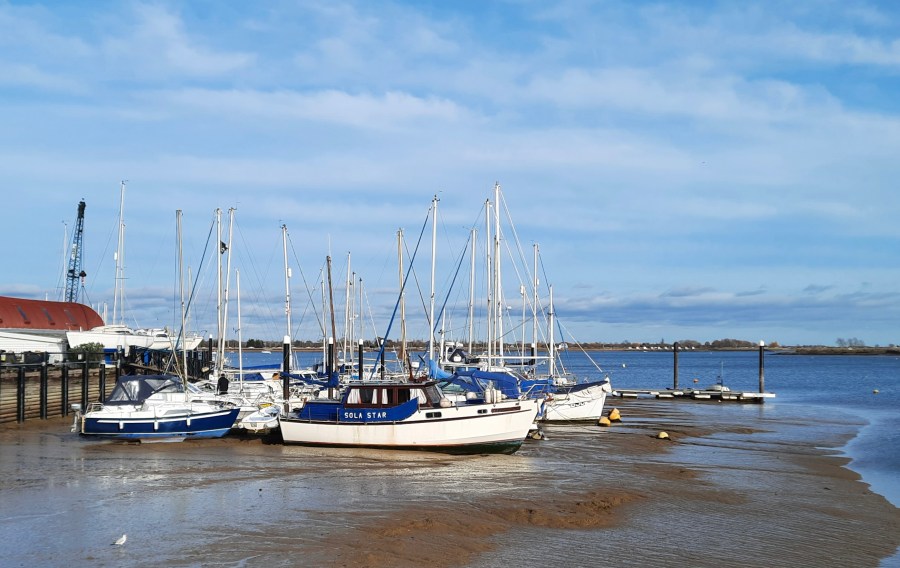From reviving wilderness walks to Thames barge sailing trips and locally produced wines, the little-known Dengie Peninsula on the Essex coast is ripe for exploration, discovers CAROLINE WHEATER.
Sheltered by undulating agricultural land, the Dengie Peninsula feels undiscovered and intriguing. With Maldon to the north and Burnham-on-Crouch to the south, this isn’t a beachy kind of place but has plenty to intrigue nevertheless.
For instance, there are peaceful walks and birdwatching opportunities out on the saltmarshes – the area is known as the Saltmarsh Coast; there’s good sailing to be had on the estuarial Rivers Crouch and Blackwater; plus a fine crop of vineyards to explore in a place that specialises in cool climate viticulture.
There’s history too. The Romans occupied the peninsula until well into the 400s, while in 653 the wonderfully named St Cedd travelled from Lindisfarne to preach the Gospel. He ordered a church to be built and St Peter-on-the-Wall still stands today in Bradwell-on-Sea, featuring bricks and stones taken from an old Roman fort.
ESSEX WINES
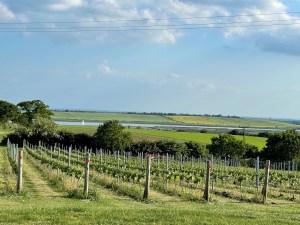
The first stop on our weekend pilgrimage, however, is a more recent phenomenon, centred on the Crouch Valley. The area is a sweet spot for growing pinot noir, chardonnay and pinot gris grapes, being sunny, dry and frost-free.
New Hall Wine Estate was the first to set up in 1969 and is now joined by 22 others, including Clayhill Vineyard run by Dale and Victoria Symons. We pop in for elevenses at their Coffee & Cake cafe and bag a table on the upstairs balcony. We take in the stupendous views over Dale’s 20 acres of vines and the glinting River Crouch beyond – we could be in France or Portugal. (Vineyard tours and tastings available. Facebook Clayhill Vineyard)
Our next stop on the wine trail is Crouch Ridge vineyard for a wine tasting. Suitably bubbly, head sommelier Laura-Jamie welcomes us on the terrace and teaches us how to taste: look at the colour, smell deeply, then swirl and slurp to tantalise the tastebuds.
We try an oaked chardonnay (apple-y and crisp), a rosé (summer berries) and a light red (smoke and sour cherries), afterwards ordering carb-rich moules marinière with chips (£15.95). (A vineyard tour and tasting costs £35 per person, crouchridge.com)
QUAYWARDS BOUND
It’s early afternoon and we head over to Burnham-on-Crouch, a yachty haven which holds Burnham Week regatta at the end of August. It’s a small place and we zip down to the riverside to see the famous Royal Corinthian Yacht Club, a Modernist gem designed by Joseph Emberton in 1931.
In contrast, on The Quay we find some beautiful old buildings dating from the 1600s such as the Anchor Hotel and meander along the quayside past quirky houseboats. The shops are still open and I dart into The Lovely Shop at 163 Station Road. Inside is an array of knitwear, bags, jewellery by Black & Sigi of Leigh-on-Sea, and products by the Maldon Soap Company, all curated by owner Donata. A definite find. (Facebook The Lovely Shop)
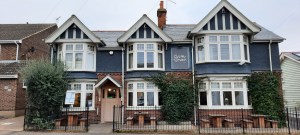
Dinner is at the Oyster Smack Inn, where we’re staying. For starters we choose crispy calamari and cheddar beignets, followed by pan-fried sea bass and fish cakes (starters from £5.50, mains from £14.95), all washed down with a bottle of pinot grigio. There’s just room for dessert and we squeeze in sticky toffee pudding and a trio of sorbets in a brandysnap basket. (theoystersmackinn.co.uk)
SALT PATHS
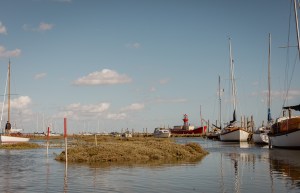
The next morning we’re up bright and early to get to Tollesbury Saltings, an atmospheric natural marina set amidst the saltmarshes and mudflats of Tollesbury Fleet on the River Blackwater, just above the Dengie Peninsula.
We walk past the boathouses and out onto the marsh to listen to the winnowing sounds of waterfowl and the clink of halyards against masts. In the distance is a bright red boat which we walk to. On arrival we discover that Trinity is a converted lightvessel and the headquarters of the Fellowship Afloat Charitable Trust (fact.org.uk), which offers activity courses for young people.
Back on dry land we pass The Loft cafe just as owners Lisa and Dave Goddard are opening up. Enticed by their sign ‘Tea by the sea’, we enter the 100-year-old sail loft and admire the vintage style interior kitted out with 1950s tables and chairs. The walls are covered with prints and paintings – some of them Lisa’s.
We choose a table by the window and order a pastrami bagel (£5) and a slice of Victoria sponge cake (£3.50) with our tea, while gazing at the art. I can’t leave without a souvenir of this life-affirming place and choose a sea storm print by Lee Thomas. (thelofttearoom.com)
SEA LOCH STOP-OFF

Half an hour later we’re at Heybridge Basin near Maldon. The 55-metre-long sea lock is the beginning of the Chelmer & Blackwater Navigation Canal, completed in 1797 to transport goods such as timber, grain and coal from the River Blackwater to Chelmsford, 13.5 miles away.
Now, the Basin is a popular marina and buzzy promenade, where visitors enjoy peeking at the houseboats and pleasure craft lining the quayside – the annual regatta is on June 17 this year.
After pottering along the tow path, we return to The Lock, a Tiptree tea room with lovely views over the river and mudflats. On the terrace outside we take Afternoon Tea for Two (£32), a monumental three-tiered cake stand bearing scones, clotted cream, jam, cakes and sandwiches. Well fed, we take five minutes to sit on the ‘kissing bench’ which has uninterrupted views over the river and watch a small wader probe for food.
TRIP INTO TOWN
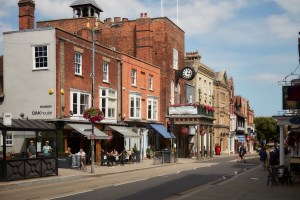
The market town of Maldon is next on the list and well worth an explore, especially because on the quayside are restored Thames barges. Tipped off by a local, we nip into Marks & Spencer to see the frontage of a c1700 apothecary’s house which is next to the booze aisle! (Planning permission required that it remained).
This is an old town with a long history. There are many Georgian facades on the High Street, but dendrochronology tests indicate that some of the timbers inside these buildings are much older. Certainly, the Swan Hotel at number 73 High Street is 15th century and reputed to host a ghost cat in the cellar.
The Grade I listed Moot Hall was built around 1420 by Sir Robert D’arcy, and its tower has walls two feet thick. It was purchased by the Town of Maldon in 1576 to use as a court house, charter house, armoury and council chamber and continues to serve the community. On the day we visit, there’s a flea market inside the Mayor’s Parlour and as we browse the nick-nacks we snatch a view of the original brick staircase going up to the rooftop viewing platform. (Book a guided tour at themoothall.co.uk)
Pleased with our discoveries, we nip into Ginny’s Cocktail Lounge at number 70B for a drink and travel light years in a matter of seconds. Tropical wall paper, pink velvet banquettes and neon signs signal that we’re somewhere hip and we order mojitos (£9.50 each).
Our final stop is the smart New Pavilion bar/restaurant in Heybridge, a family business with friendly, quick service. The food is fresh, tasty and good value: pan fried sardines to share (£8.50), cod and chips with wally and pea puree (£15.50), burger with bacon and melted cheddar (£15.50), and an apple and peach crumble dessert (£7) to finish the meal. It’s a nice end to a great stay.
To plan a trip to the Dengie Peninsula and surrounds, browse visitessex.com.
WHERE TO STAY
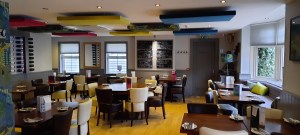
Coast stayed at the Oyster Smack Inn on Station Road, Burnham-on-Crouch, run by chef proprietor Trevor Howell and his wife Claire. There are ten guest rooms, from £105 per room (including continental breakfast; cooked breakfast is extra). We stayed in number 9, a Superior room which is quiet, large and comfortable.
If you’re staying a couple of nights, dinner in the restaurant is a must as Trevor has done stints for Jamie Oliver and Gordon Ramsay. The flavoursome menu isn’t pretentious or expensive, but includes dishes such as sharing platters and pre-starters like spiced nuts and cheesy garlic bread, which is a nice touch. (01621 782 141, theoystersmackinn.co.uk)
SAIL ON A RESTORED THAMES BARGE

A highlight of our visit is an hour-and-a-half sailing trip on a restored Thames barge, leaving from Maldon Quay. In the 19th and early 20th centuries, a 2,000-strong fleet of Thames barges operated along the east coast, ferrying goods north and south.
We climb aboard Hydrogen, the largest wooden barge still sailing, to cruise along the River Blackwater. Built in 1906, Hydrogen was a ‘coasting barge’ which traded in London and as far north as Edinburgh. She could carry 220 tons of cargo such as coal, oil, tar and grain. She was taken out of service in 1976 and was restored in the early 1990s, and now she’s a regular at sail festivals.
As the tide wafts us out onto the river we get a seabird’s eye view of the terrain – Northey Island, Heybridge Basin and Mill Beach and watch small sail boats scud across the water and seabirds out hunting.
Once out on the main body of water, with the wind blowing, first mate Alfie raises the huge red sails and with skipper Paul at the helm, Hydrogen ploughs purposefully on her journey. It’s a wonderful experience and well worth the money.
An hour-and-a-half hour trip on a restored Thames Barge run by Topsail Charters costs £32 per adult, £22 per child; other cruises are available. (top-sail.co.uk)
Want to see more of Essex? Take a look at our weekend guide to exploring Essex.

